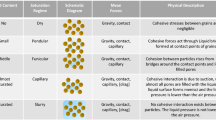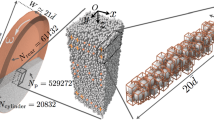Abstract
A detailed study on similarities and differences of monodisperse dry and wet dense granular flow down on rough and smooth inclined planes was carried out by discrete element method simulations. Despite implementing a minimal model for capillary bridge cohesive force, all leading regimes of a granular flow, i.e. low-dissipation, high-dissipation, and oscillatory flow, can be developed in wet granular flow, similar to what we knew in the dry one. A smooth and rough based inclined planes as well as different inclination angels were used as parameters to create various flow regimes in dry and wet granular flow. In the oscillatory flow regime, the frequency of velocity profile variation is lower than that of the dry one. The velocity profile of the wet system in the low-dissipation flow regime exhibits an abrupt slope change at shear band bottom. As a measure of particle velocity fluctuations we have studied granular temperature in layers parallel to the inclined base. We found the temperature profile is increasing from the top to bottom, which means the shear band can be considered as a frozen region. By calculation of Radial Distribution Function (RDF) and using the adaptive Common Neighbor Analysis (a-CNA), the evolution of ordered/disordered structures in both dry and wet models is studied. In a wet system in the low-dissipation regime, the shear band exhibits frozen polycrystalline structure and in the bottom slice, in spite of having layered flow in the scale of one granule, we have a low fraction of crystallization. This study gives insightful key differences between wet and dry monodisperese granular flows, specifically the appearance of ordering and presence of crystalizations in different parts of high and low dissipation flow.
Graphic abstract

































Similar content being viewed by others
References
Fingerle, A., Roeller, K., Huang, K., Herminghaus, S.: Phase transitions far from equilibrium in wet granular matter. New J. Phys. 10, 053020 (2008). https://doi.org/10.1088/1367-2630/10/5/053020/
Ulrich, S., Aspelmeier, T., Zippelius, A., Roeller, K., Fingerle, A., Herminghaus, S.: Dilute wet granular particles: nonequilibrium dynamics and structure formation. Phys. Rev. E 80, 031306 (2009). https://doi.org/10.1103/PhysRevE.80.031306
Schröter, M., Ulrich, S., Kreft, J., Swift, J.B., Swinney, H.L.: Mechanisms in the size segregation of a binary granular mixture. Phys. Rev. E 74, 011307 (2006). https://doi.org/10.1103/PhysRevE.74.011307
Azéma, E., Radjaï, F.: Internal structure of inertial granular flows. Phys. Rev. Lett. 112, 078001 (2014). https://doi.org/10.1103/PhysRevLett.112.078001
Börzsönyi, T., Stannarius, R.: Granular materials composed of shape-anisotropic grains. Soft Matter 9, 7401 (2013). https://doi.org/10.1039/C3SM50298H
Scheel, M., Seemann, R., Brinkmann, M., Di Michiel, M., Sheppard, A., Breidenbach, B., Herminghaus, S.: Morphological clues to wet granular pile stability. Nat. Mater. 7, 189 (2008). https://doi.org/10.1038/nmat2117
Nan, W., Ghadiri, M., Wang, Y.: Analysis of powder rheometry of FT4: Effect of air flow. Chem. Eng. Sci. 162, 141 (2017). https://doi.org/10.1016/j.ces.2017.01.002
Madadi Najafabadi, A.H., Masoumi, A., Vaez-Allaei, S.M.: Analysis of abrasive damage of iron ore pellets. Powder Technol. 331, 20 (2018). https://doi.org/10.1016/j.powtec.2018.02.030
Baule, A., Morone, F., Herrmann, H.J., Makse, H.A.: Edwards statistical mechanics for jammed granular matter. Rev. Mod. Phys. 90, 015006 (2018). https://doi.org/10.1103/RevModPhys.90.015006
Francois, N., Saadatfar, M., Cruikshank, R., Sheppard, A.: Geometrical frustration in amorphous and partially crystallized packings of spheres. Phys. Rev. Lett. 111, 148001 (2013). https://doi.org/10.1103/PhysRevLett.111.148001
Hanifpour, M., Francois, N., Vaez Allaei, S.M., Senden, T., Saadatfar, M.: Mechanical characterization of partially crystallized sphere packings. Phys. Rev. Lett. 113, 148001 (2014). https://doi.org/10.1103/PhysRevLett.113.148001
Hanifpour, M., Francois, N., Robins, V., Kingston, A., Vaez Allaei, S.M., Saadatfar, M.: Structural and mechanical features of the order-disorder transition in experimental hard-sphere packings. Phys. Rev. E 91, 062202 (2015). https://doi.org/10.1103/PhysRevE.91.062202
Jing, L., Kwok, C.Y., Leung, Y.F., Sobral, Y.D.: Characterization of base roughness for granular chute flows. Phys. Rev. E 94, 052901 (2016). https://doi.org/10.1103/PhysRevE.94.052901
Kumaran, V., Maheshwari, S.: Transition due to base roughness in a dense granular flow down an inclined plane. Phys. Fluids 24, 053302 (2012). https://doi.org/10.1063/1.4710543
Carvente, O., Ruiz-Suárez, J.C.: Self-assembling of dry and cohesive non-Brownian spheres. Phys. Rev. E 78, 011302 (2008). https://doi.org/10.1103/PhysRevE.78.011302
Silbert, L.E., Ertaş, D., Grest, G.S., Halsey, T.C., Levine, D., Plimpton, S.J.: Granular flow down an inclined plane: Bagnold scaling and rheology. Phys. Rev. E 64, 051302 (2001). https://doi.org/10.1103/PhysRevE.64.051302
Brewster, R., Grest, G.S., Landry, J.W., Levine, A.J.: Plug flow and the breakdown of Bagnold scaling in cohesive granular flows. Phys. Rev. E 72, 061301 (2005). https://doi.org/10.1103/PhysRevE.72.061301
Ebrahimnazhad Rahbari, S.H., Vollmer, J., Herminghaus, S., Brinkmann, M.: A response function perspective on yielding of wet granular matter. EPL (Europhysics Letters) 87, 14002 (2009). https://doi.org/10.1209/0295-5075/87/14002
Silbert, L.E., Landry, J.W., Grest, G.S.: Granular flow down a rough inclined plane: transition between thin and thick piles. Phys. Fluids 15, 1 (2003). https://doi.org/10.1063/1.1521719
Delannay, R., Louge, M., Richard, P., Taberlet, N., Valance, A.: Towards a theoretical picture of dense granular flows down inclines. Nat. Mater. 6, 99 (2007). https://doi.org/10.1038/nmat1813
Saingier, G., Deboeuf, S., Lagrée, P.-Y.: On the front shape of an inertial granular flow down a rough incline. Phys. Fluids 28, 053302 (2016). https://doi.org/10.1063/1.4948401
Rognon, P.G., Roux, J.-N., Naaïm, M., Chevoir, F.: Dense flows of cohesive granular materials. J. Fluid Mech. 596, 21–47 (2008). https://doi.org/10.1017/S0022112007009329
Herminghaus, S.: Dynamics of wet granular matter. Adv. Phys. 54, 221 (2005). https://doi.org/10.1080/00018730500167855
Strauch, S., Herminghaus, S.: Wet granular matter: a truly complex fluid. Soft Matter 8, 8271 (2012). https://doi.org/10.1039/C2SM25883H
Richefeu, V., El Youssoufi, M.S., Radjaï, F.: Shear strength properties of wet granular materials. Phys. Rev. E 73, 051304 (2006). https://doi.org/10.1103/PhysRevE.73.051304
Khamseh, S., Roux, J.-N., Chevoir, F.: Flow of wet granular materials: a numerical study. Phys. Rev. E 92, 022201 (2015). https://doi.org/10.1103/PhysRevE.92.022201
Brewster, R., Grest, G.S., Levine, A.J.: Effects of cohesion on the surface angle and velocity profiles of granular material in a rotating drum. Phys. Rev. E 79, 011305 (2009). https://doi.org/10.1103/PhysRevE.79.011305
Chou, S.H., Hsiau, S.S.: Experimental analysis of the dynamic properties of wet granular matter in a rotating drum. Powder Technol. 214, 491 (2011). https://doi.org/10.1016/j.powtec.2011.09.010
Silbert, L.E., Grest, G.S., Plimpton, S.J., Levine, D.: Boundary effects and self-organization in dense granular flows. Phys. Fluids 14, 2637 (2002). https://doi.org/10.1063/1.1487379
de Ryck, A.: Granular flows down inclined channels with a strain-rate dependent friction coefficient: part II—cohesive materials. Granular Matter 10, 361 (2008). https://doi.org/10.1007/s10035-008-0106-2
Ebrahimnazhad-Rahbari, S.H., Khadem-Maaref, M., Seyed-Yaghoubi, S.K.A.: Universal features of the jamming phase diagram of wet granular materials. Phys. Rev. E 88, 042203 (2013). https://doi.org/10.1103/PhysRevE.88.042203
Ebrahimnazhad Rahbari, S.H., Vollmer, J., Herminghaus, S., Brinkmann, M.: Fluidization of wet granulates under shear. Phys. Rev. E 82, 061305 (2010). https://doi.org/10.1103/PhysRevE.82.061305
Ebrahimnazhad Rahbari, S.H., Brinkmann, M., Vollmer, J.: Arrest stress of uniformly sheared wet granular matter. Phys. Rev. E 91, 062201 (2015). https://doi.org/10.1103/PhysRevE.91.062201
Roeller, K., Blaschke, J., Herminghaus, S., Vollmer, J.: Arrest of the flow of wet granular matter. J. Fluid Mech. 738, 407–422 (2014). https://doi.org/10.1017/jfm.2013.587
Ghaboussi, J., Barbosa, R.: Three-dimensional discrete element method for granular materials. Int. J. Numer. Anal. Methods Geomech. 14, 451 (1990). https://doi.org/10.1002/nag.1610140702
Guo, Y., Curtis, J.S.: Discrete element method simulations for complex granular flows. Ann. Rev. Fluid Mech. 47, 21 (2015). https://doi.org/10.1146/annurev-fluid-010814-014644
Luding, S.: Introduction to discrete element methods: basic of contact force models and how to perform the micro-macro transition to continuum theory. Eur. J. Environ. Civ. Eng. 12, 785 (2008). https://doi.org/10.1080/19648189.2008.9693050
Yoshimatsu, R., Araújo, N.A.M., Shinbrot, T., Herrmann, H.J.: Segregation of charged particles under shear. Granular Matter 20, 35 (2018). https://doi.org/10.1007/s10035-018-0806-1
Kloss, C., Goniva, C., Hager, A., Amberger, S., Pirker, S.: Models, algorithms and validation for opensource DEM and CFD-DEM. https://doi.org/10.1504/PCFD.2012.047457; LIGGGHTS- Open Source Discrete Element Method Particle Simulation Software Based on Lammps (2019). http://www.cfdem.com
https://github.com/DiscreteLogarithm/capillary-LAMMPS-LIGGGHTS
Brilliantov, N.V., Spahn, F., Hertzsch, J.-M., Pöschel, T.: Model for collisions in granular gases. Phys. Rev. E 53, 5382 (1996). https://doi.org/10.1103/PhysRevE.53.5382
Zhang, H.P., Makse, H.A.: Jamming transition in emulsions and granular materials. Phys. Rev. E 72, 011301 (2005). https://doi.org/10.1103/PhysRevE.72.011301
Just, S., Toschkoff, G., Funke, A., Djuric, D., Scharrer, G., Khinast, J., Knop, K., Kleinebudde, P.: Experimental analysis of tablet properties for discrete element modeling of an active coating process. AAPS PharmSciTech. 14, 402 (2013). https://doi.org/10.1208/s12249-013-9925-5
Chand, R., Khaskheli, M.A., Qadir, A., Ge, B., Shi, Q.: Discrete particle simulation of radial segregation in horizontally rotating drum: Effects of drum-length and non-rotating end-plates. Phys. A Stat. Mech. Appl. 391, 4590 (2012). https://doi.org/10.1016/j.physa.2012.05.019
Stukowski, A.: Visualization and analysis of atomistic simulation data with OVITO: the Open Visualization Tool. Model. Simul. Mater. Sci. Eng. 18, 015012 (2009). https://doi.org/10.1088/0965-0393/18/1/015012
Schulz, M., Schulz, B.M., Herminghaus, S.: Shear-induced solid-fluid transition in a wet granular medium. Phys. Rev. E 67, 052301 (2003). https://doi.org/10.1103/PhysRevE.67.052301
Becerríl-González, J.J., Peñuñuri, F., Zambrano, M.A., Acosta, C., Carvente, O.: Radial distribution function at the particle-bottom interface in granular self-assembly. J. Phys. Conf. Ser. 792, 012052 (2017). https://doi.org/10.1088/1742-6596/792/1/012052
Jia, T., Zhang, Y., Chen, J.K.: Simulation of granular packing of particles with different size distributions. Comput. Mater. Sci. 51, 172 (2012). https://doi.org/10.1016/j.commatsci.2011.07.044
Stukowski, A.: Structure identification methods for atomistic simulations of crystalline materials. Model. Simul. Mater. Sci. Eng. 20, 045021 (2012). https://doi.org/10.1088/0965-0393/20/4/045021
Honeycutt, J.D., Andersen, H.C.: Molecular dynamics study of melting and freezing of small Lennard-Jones clusters. J. Phys. Chem. 91, 4950 (1987). https://doi.org/10.1021/j100303a014
Jung, J., Gidaspow, D., Gamwo, I.K.: Measurement of two kinds of granular temperatures, stresses, and dispersion in bubbling beds. Ind. Eng. Chem. Res. 44, 1329 (2005). https://doi.org/10.1021/ie0496838
He, Y., Wang, T., Deen, N., van Sint-Annaland, M., Kuipers, H., Wen, D.: Discrete particle modeling of granular temperature distribution in a bubbling fluidized bed. Particuology 10, 428 (2012). https://doi.org/10.1016/j.partic.2012.02.001
Acknowledgement
The authors gratefully acknowledge fruitful discussions with Jürgen Vollmer, Stefan Luding, S. Habib Ebrahimnazhad Rahbari, Tamás Börzsönyi, and Ellák Somfai. We acknowledge the computing resources provided by the Center for High-Performance Computing at the Department of Physics of the University of Tehran.
Author information
Authors and Affiliations
Corresponding author
Ethics declarations
Conflict of interest
The authors declare that they have no conflict of interest.
Additional information
Publisher's Note
Springer Nature remains neutral with regard to jurisdictional claims in published maps and institutional affiliations.
Appendix
Appendix
The \(k_{n}\), \(k_{t}\), \(\gamma _{n}\), and \(\gamma _{t}\) coefficients are calculated from the material properties according to Table 1, for the Hertz-Mindlin model [16, 41,42,43,44]. In this table Y is Young’s modulus, G is the shear modulus, \(\nu \) is the Poisson ratio, e is the coefficient of restitution, m is the mass and R is the radius of a particle.
Rights and permissions
About this article
Cite this article
Moharamkhani, H., Sepehrinia, R., Taheri, M. et al. Ordered/disordered monodisperse dense granular flow down an inclined plane: dry versus wet media in the capillary bridge regime. Granular Matter 23, 62 (2021). https://doi.org/10.1007/s10035-021-01115-4
Received:
Accepted:
Published:
DOI: https://doi.org/10.1007/s10035-021-01115-4




